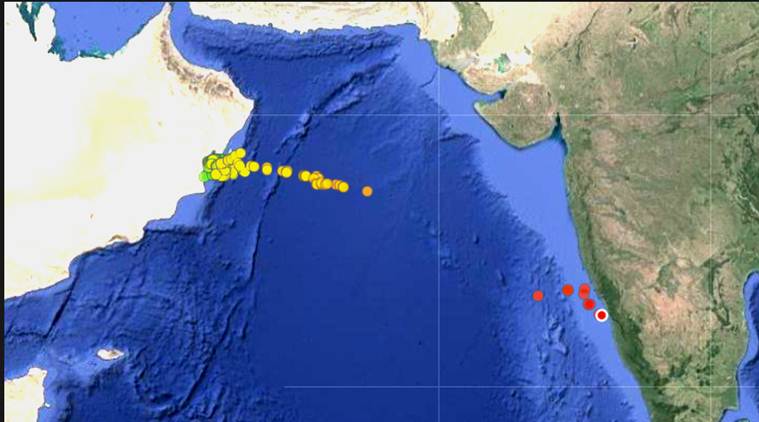- India
- International
Kerala’s New Year guest: A female humpback whale, all the way from Oman
Though humpback whales, over the world, are known to migrate between polar and tropical regions, the ones found in the Arabian Sea, numbering around 100, don't stray far, making them the most isolated whale population on earth.
 An Arabian humpback whale off the coast of Oman(Source: T. Collins and D. MacDonald/Wikimedia)
An Arabian humpback whale off the coast of Oman(Source: T. Collins and D. MacDonald/Wikimedia)
On November 12 last year, when Luban, a female humpback whale, began migrating eastwards in the Indian Ocean leaving her pod far behind in the Gulf of Oman, it took scientists by surprise. She had not been known to do that. By December 31, it was clear that Luban had decided to welcome the new year off the coast of Kochi in Kerala, having swam over 1500 kilometres across the Arabian Sea. Proving past genetic studies wrong, Luban achieved a rare feat by making the first recorded trans-oceanic crossing by an Arabian humpback whale.
Though humpback whales, over the world, are known to migrate between polar and tropical regions, the ones found in the Arabian Sea, numbering around 100, don’t stray far, making them the most isolated whale population on earth, according to scientists. According to a 2014 research study, Arabian humpback whales may even have stayed separate from other humpback species for nearly 70,000 years. But Luban’s landmark journey has changed all that.
 Luban’s journey across the Arabian Sea was tracked by satellites. (Source: Environment Society of Oman)
Luban’s journey across the Arabian Sea was tracked by satellites. (Source: Environment Society of Oman)
“The fact that one female has now moved outside Omani waters during the known breeding season makes this theory concerning connectivity across the region more likely, and a first step towards considering humpbacks in the region as a single population unit,” said Andrew Willson from Five Oceans Environmental Services in a statement.
The name Luban, an Arabic term for frankincense tree, was given to the female whale as she is learnt to have a tree-shaped pattern at the base of her tail fluke. She was the only female to be tagged with a transmitter among 14 whales by the Environment Society of Oman (ESO) under a project through which they aim to learn more about the habitats of the mammals as well as their population estimates.

Luban’s journey across the Arabian Sea was tracked by satellites. Prior to Christmas, she had come close to the Goan coast and then moving swiftly at a speed of 5 kms/hr towards the coast of Kerala. According to local scientists, she is believed to have spent a couple of days near the Kochi coast before moving once again towards Alappuzha and the southern coast. Her last location was pinpointed to be near the coast of Kanyakumari.

“Frankly, we don’t know why she is here. She may be possibly looking for a mate. Some fishermen told us that they saw a whale but of course they couldn’t identify the species. We also don’t know whether she is alone,” said Professor A Biju Kumar, the head of the department of aquatic biology and fisheries at Kerala University.
Kumar and Dr Dipani Sutaria, a marine biologist, are the Indian researchers coordinating with ESO in tracking the movements of the whale. Along with Kumar, Dr Sutaria, was aboard a Coast Guard ship on New Year’s Day off the coast of Kochi trying to locate Luban. But they couldn’t.
“We followed Luban based on her last location. But by the time the signal came to us via the transmitter, a few hours had passed. She had gone by then. We wanted to see what mystery she was up to,” said Dr Sutaria, by phone.
The sighting of a humpback whale, nevertheless, in Indian waters is considered special. Each individual can be identified as they have distinct tail flukes with white markings. According to Kumar, Blue Whales and Bryde’s Whales are more commonly spotted in the Indian waters. Malayali fishermen are known to stand up in their boats and pray when they see a whale, which they refer to as ‘kadal aana’ (sea elephant in local parlance).
With Luban’s journey, scientists are optimistic about finding more about the Arabian humpback species, which are listed as ‘endangered’ on the red list of the International Union for Conservation of Nature (IUCN). Massive whaling in the 60s had reduced their numbers to a great extent.
As to what direction Luban might take from Kanyakumari, Dr Sutaria was not sure. “We don’t know where she would go. There are a few humpbacks near Sri Lanka. Whether she would go further south in that direction, we can’t be sure.”
“You know, the batteries on the transmitter attached to her dorsal fin work for only 45 days. So they may run out any day. We are hoping to get a couple of days more to know where she is headed,” she added.
Apr 24: Latest News
- 01
- 02
- 03
- 04
- 05







































